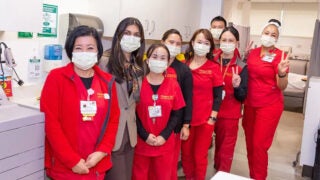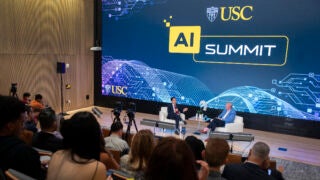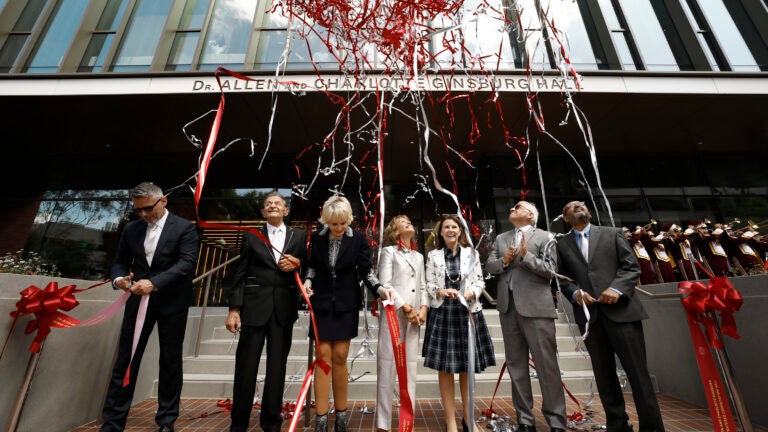
Celebrating the ribbon-cutting are, from left: Professor Nenad Medvidović; Allen and Charlotte Ginsburg; USC President Carol Folt; USC Trustee Chair Suzanne Nora Johnson; USC Viterbi Dean Yannis Yortsos; and Director Gaurav Sukhatme of the USC School of Advanced Computing. (USC Photo/Steve Cohn)
USC celebrates opening of Dr. Allen and Charlotte Ginsburg Human-Centered Computation Hall
The new building is a “home for the next generation of creators, inventors and discoverers” and central to USC President Carol Folt’s historic Frontiers of Computing “moonshot.”
“A revolutionary space.” That’s how USC President Carol Folt described the new Dr. Allen and Charlotte Ginsburg Human-Centered Computation Hall during Tuesday’s ribbon-cutting ceremony for the state-of-the-art new building.
“We open this hall today as a home for the next generation of creators, inventors and discoverers,” Folt said. As the home for the Thomas Lord Department of Computer Science and the USC School of Advanced Computing, “it is literally building the future — across every field of human endeavor,” she added.
The building — a 116,000-square-foot, seven-story structure featuring a striking glass facade — is a centerpiece in Folt’s Frontiers of Computing “moonshot,” a more than $1 billion initiative that supports ethical advancement in areas such as artificial intelligence, robotics and advanced computing. It was made possible by a naming gift from philanthropists Allen and Charlotte Ginsburg, first announced in 2020.
Designed by renowned architecture firm HOK, the cutting-edge hub will serve as a physical embodiment of USC’s mission to infuse computing with disciplines across the university, strengthen core computer science, and advance the ethical, social and “human-centered” dimensions of computing.
A people collider
The LEED Platinum-certified building houses a two-story lab dedicated to the research and testing of flying autonomous aerial vehicles; advanced, open-plan robotics labs; student collaboration labs and creativity zones; and a 300-seat auditorium and amphitheater. It will also serve as a dynamic “living lab,” allowing researchers to study how the building operates in real-life conditions and explore and implement eco-friendly practices.
All of this, Folt said, was designed with one purpose in mind: to make this building a people collider. “That takes a lot of human innovation,” she said. “The more than 500,000 hours of labor, 12 million pounds of concrete and 145,000 bricks only begin to tell that story.”
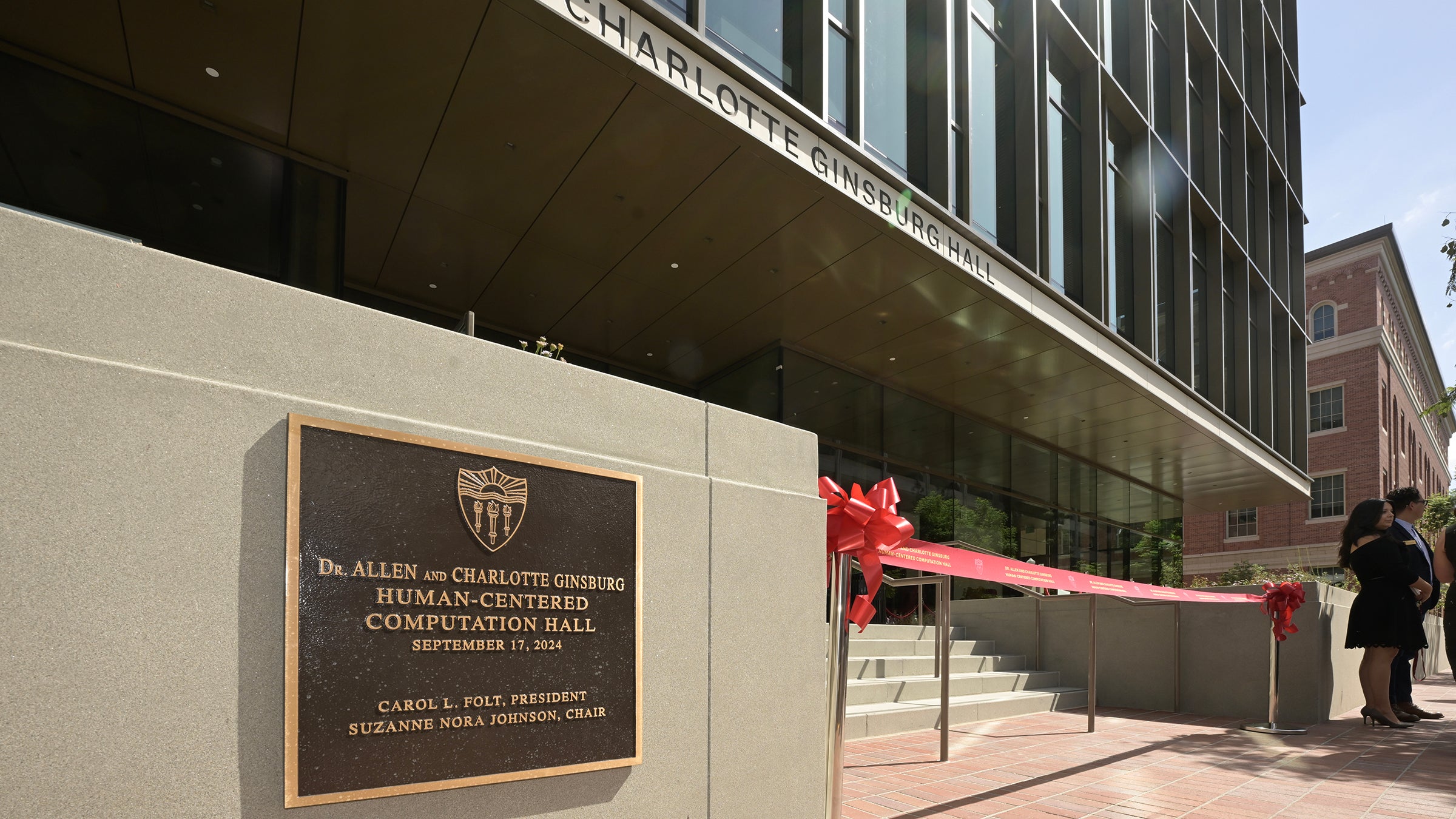
The design supports the Ginsburgs’ firm belief in the power of computing to change the human condition and of creativity to advance the prospects for humanity, Folt said.
Paraphrasing Swiss psychologist Jean Piaget, she added: “The principal goal of an education in computing is to create people who are capable of doing new things, and not simply of repeating what other generations have done.”
She spoke of the Ginsburgs’ vision and hope for computing: to bring us a better world. “That belief will always resonate here in this building,” Folt said. “You can be assured that professors, students and researchers will always draw inspiration from them — as they work to ensure that computing delivers that promise.”
Folt also shared her appreciation for the Ginsburgs’ transformative gift and its undoubtedly far-reaching impact: “On behalf of USC, thank you again for a gift that will forever make a difference for our students, faculty and staff — and for the world.”
A history-making initiative
Yannis Yortsos, dean of the USC Viterbi School of Engineering, took the audience down memory lane — back to the spring of 2019 when the site of the gleaming new building was still a parking lot.
That was the year when the Lord Foundation of California made a seminal gift to USC and set the wheels in motion for the single largest comprehensive academic initiative in the university’s history: Frontiers of Computing.
“Five years later, this incredible gift helped launch President Folt’s historic moonshot on the Frontiers of Computing,” Yortsos said. “Thank you, Carol, for this history-making initiative. It is an integral part of what we are celebrating today.”
The seeds for Ginsburg Hall were sown with a vision to complete a campus trifecta, Yortsos said, joining the USC Michelson Center for Convergent Bioscience and the Ray Irani Hall for Molecular and Computational Biology. Together, these facilities would enable faculty and students to tackle today’s most pressing challenges, from cancer research to climate change.
“Today, we celebrate this completed trifecta — a unique, world-leading convergence,” Yortsos said. “But this history would not have happened, of course, without the unbending support of President Folt and the generosity of the Ginsburgs.”
Beyond providing material support, Yortsos said, the Ginsburgs have also enriched USC with “their joie de vivre, their spirituality and their incredible commitment to creating a world of goodness and grace.”
“Their incredible legacy will help to advance the solution of … grand-challenge-like problems in … sustainability, health and security. With technology and humanity intertwined as never before, these are all human-centric endeavors. They will take place in Ginsburg Hall.”
Advancing the digital revolution
“Well, I can’t believe we’re finally here — I had to pinch myself this morning,” said Gaurav Sukhatme, director of the School of Advanced Computing.
“We are already out front in so many ways: research, faculty excellence and student diversity,” he said. “Now, with Ginsburg Hall, we have a place where all of this comes together.”
The opening of Ginsburg Hall comes just a few months after the announcement to establish the School of Advanced Computing, a “school within a school” inside USC Viterbi, and the naming of the Thomas Lord Department of Computer Science.
“Both signature events showcase what has become a central truth: Computing has changed the world in ways that were unimaginable when I started at USC as a graduate student more than 30 years ago,” Sukhatme said. “And Ginsburg Hall will be a place where that continues. It will be a place to advance the digital revolution. A place to gather, create, communicate and collaborate.”
Sukhatme envisions a school without silos, fostering interdisciplinary collaboration across disparate fields, from medicine and health to business and the arts.
“In this building, work of all types — in all fields — will emerge,” he said. “USC’s longstanding and well-acknowledged strength across all our schools is very real, and our dedication is unwavering.”
Sukhatme closed by thanking Folt for her “steadfast belief”; Yortsos for his “visionary leadership”; and the Ginsburgs, whom he described as “the best partners a university could ask for,” for “indelibly changing our campus, and the world.”
Dream big
Taking the stage amid resounding applause, Allen Ginsburg thanked the community united in a passion for advancing education, beautiful minds and innovation. “It’s exciting to tour this beautiful building, starting in the grand foyer with its amazing magical entries,” he said.
Allen Ginsburg saw his first computer at the age of 16 at Rockefeller Center in New York. “Today, the cellphones in our pockets have more computing power than the 7-foot-tall IBM unit that mesmerized young Ginsburg,” Folt said. “That’s power most likely created by a Trojan, many of them from Viterbi.”
During their speeches, both Folt and the Ginsburgs gave a heartfelt acknowledgment to USC Trustee Rod Nakamoto, who initially introduced the Ginsburgs to USC and was instrumental in bringing the building’s vision to life.
The new building is just the latest example of the Ginsburgs’ dedicated support for USC and other universities across the region.
“Lady Charlotte and I are enchanted with beautiful minds, which have taken us from likely extinction to the Industrial Revolution, to microchips, semiconductors and the brink of AI and robotics,” Ginsburg said. “We are privileged to be aboard and involved in this exciting enterprise.”
Charlotte Ginsburg said she was “filled with gratitude and excitement” in celebrating “not just a building, but a living building and advancing education.” Joined at the event by family from five different states, she honored her husband, “the love of my life and a futurist” who is always thinking: “What can we do to make the world a better place?”
“As we look forward to the many opportunities this space will provide, let us remember that it is the collective effort of all of you that has made this possible,” she said. “This building stands as a testament to our shared values and commitment to making a difference in the world. I am thrilled to know that this space will inspire future generations of engineers and professionals to dream big and pursue their passions.”
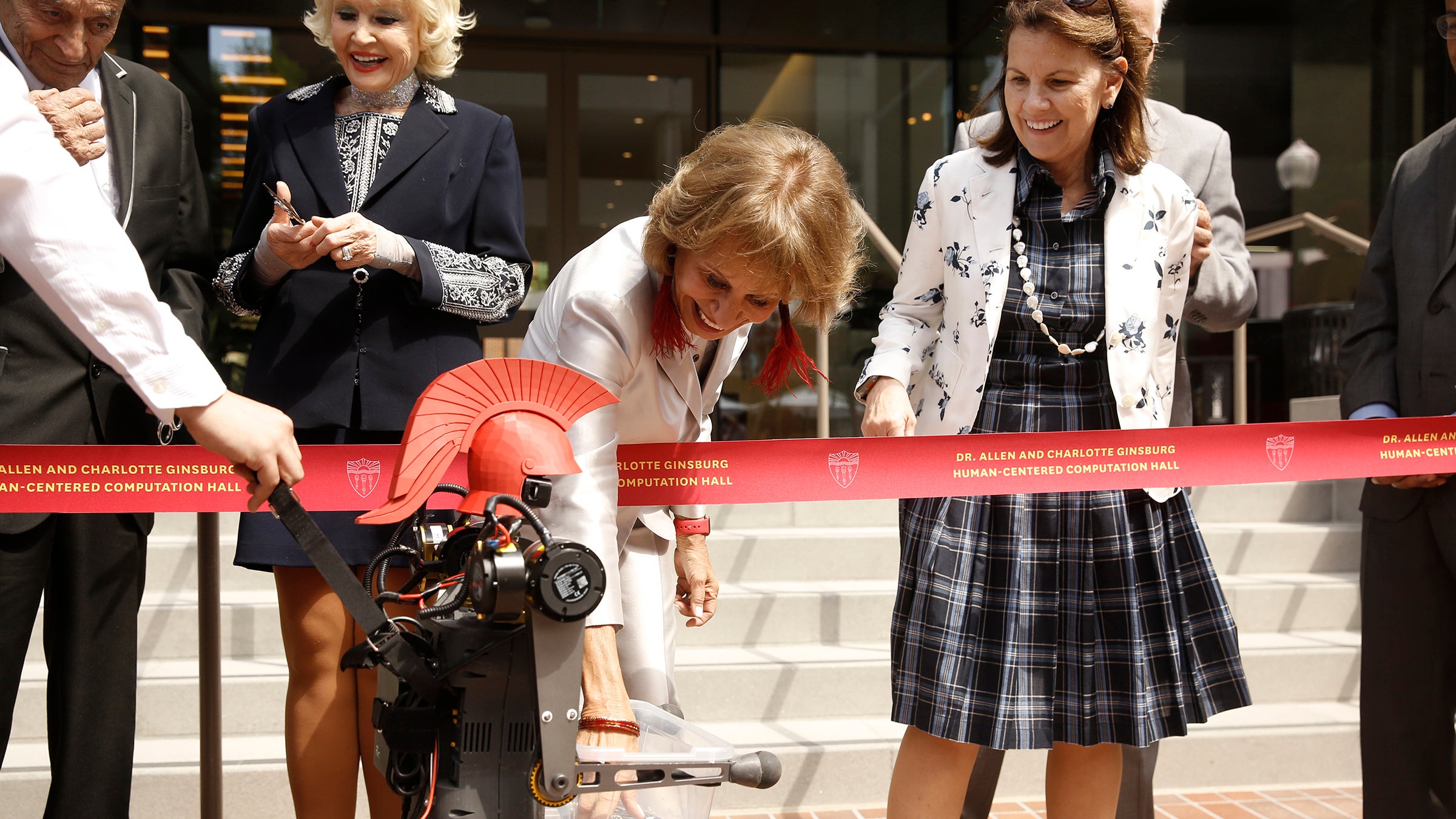
As the ceremony concluded, one final guest was introduced: HECTOR, the humanoid robot, from the lab of Professor Quan Nguyen, a professor of aerospace and mechanical engineering and computer science. Taking careful steps in tiny shoes, with a tilt to its little Troy hat, HECTOR — Humanoid for Enanced ConTrol and Open-source Research — delivered the scissors for the momentous ribbon cutting as vibrant streamers burst behind the guests, capturing the joyful, innovative spirit of USC’s newest building.

